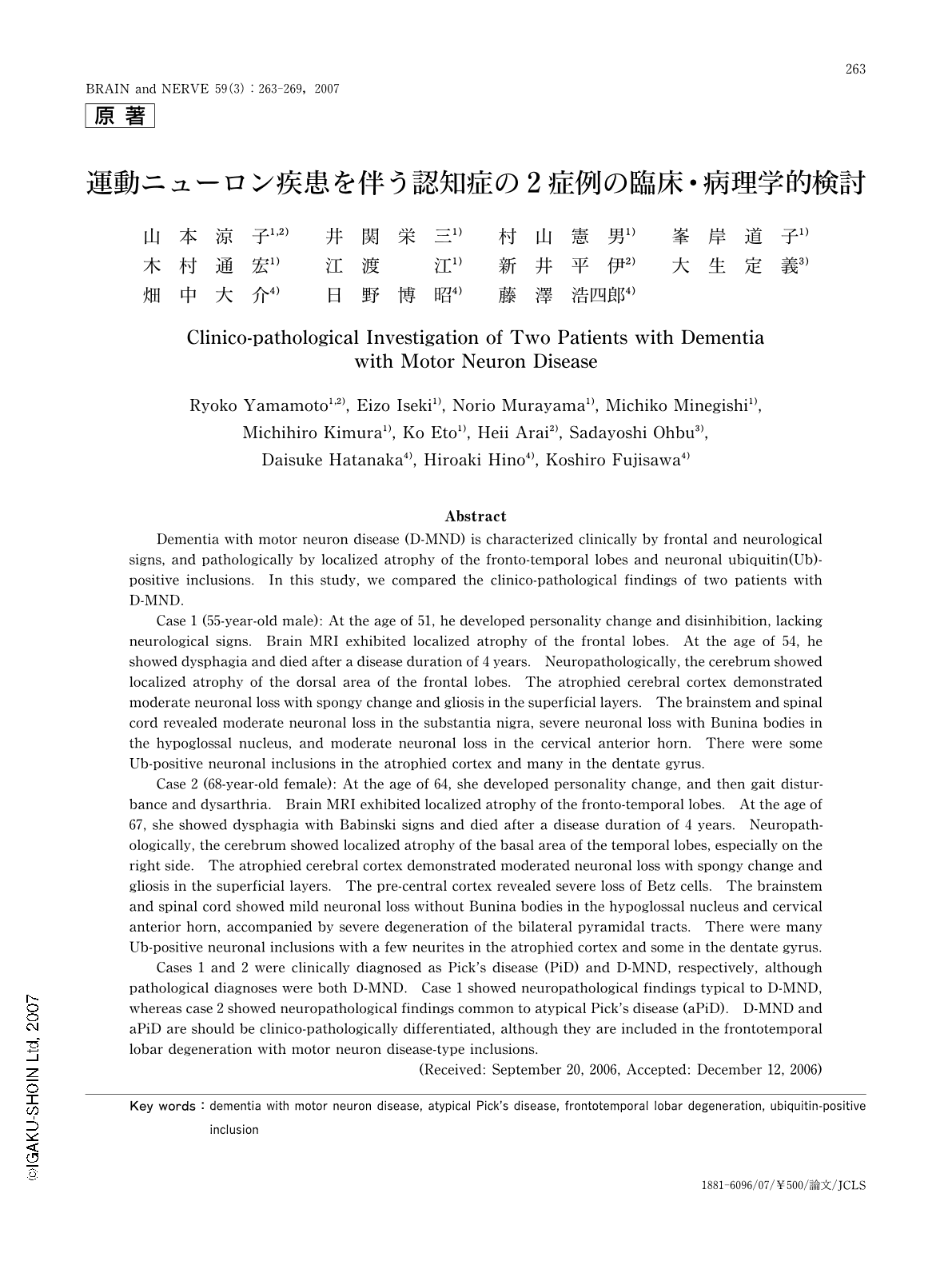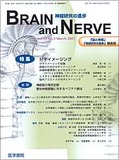Japanese
English
- 有料閲覧
- Abstract 文献概要
- 1ページ目 Look Inside
- 参考文献 Reference
はじめに
運動ニューロン疾患を伴う認知症(dementia with motor neuron disease: D-MND)は認知機能障害と筋萎縮を伴う運動障害をきたす疾患で,前頭側頭型認知症(frontotemporal dementia: FTD)の運動ニューロン疾患型に相当する。FTDは1994年に提唱された新しい疾患概念で1),従来のピック病(Pick's disease: PiD)の概念を発展させたものであり,前頭・側頭葉の前方部に優位な萎縮を示す非アルツハイマー型変性性認知症の総称である。FTDの神経病理学的亜型として,前頭葉変性型・ピック型・運動ニューロン疾患型の3型が挙げられている。
従来PiDとされていたもののうち,前頭葉優位の萎縮を示すものはFTDのピック型に相当するが,側頭葉優位の萎縮を示すものはFTDには含められないことから,FTDに進行性非流暢性失語,意味性認知症を加えた概念として,前頭側頭葉変性症(frontotemporal lobar degeneration: FTLD)が新たに提唱された2)。前頭葉優位の萎縮を示すPiDは,人格変化や脱抑制などの前頭葉症状で発症し,神経病理学的にリン酸化タウの蓄積よりなるピック小体を有しており,狭義のPiDはこのタイプを指す。一方,側頭葉優位の萎縮を示すPiDは,語義失語で発症して意味性認知症を示すことが多く,神経病理学的にピック小体を持たず,ユビキチン陽性封入体を有しており,非定型ピック病(atypical Pick's disease: aPiD)と呼ばれている3,4)。
わが国のD-MNDは,1964年に湯浅5)が認知症を伴う筋萎縮性側索硬化症(amyotrophic lateral sclerosis with dementia: ALS with dementia)として臨床報告し,1979年にMitsuyamaら6)によって運動ニューロン疾患を伴う初老期認知症(presenile dementia with motor neuron disease)の名称で1疾患として提唱された。臨床的には,初老期に人格変化や脱抑制などの前頭葉症状と言語障害で発症することが多い。神経症状の多くは認知機能障害の発症後1年以内に併発し,線維性攣縮を伴う上肢の筋萎縮と球麻痺がみられる。神経病理学的にはPiDのような強い限局性萎縮はなく,ALSほど強い脊髄病変もない。Okamotoら7)によってD-MNDの海馬歯状回と前頭・側頭葉皮質の神経細胞にaPiDと類似したユビキチン陽性封入体が示されている。
このように,FTLDは異なる病態機序を持つ疾患を包括した臨床症候群であり,臨床診断基準として「社会的対人行動の早期からの障害」や「早期からの自己行動の統制障害」などの必須症状と,従来のPiDの症状に一致する常同行動や食行動異常などの支持症状が挙げられている8)。しかしながら,この基準では病初期には各亜型の鑑別が困難なことが多く,例えば,初期に運動障害がみられず前頭葉症状が前景に立ち,画像上で前頭葉の限局性萎縮を示す場合は,PiDとD-MNDを区別することができない。
今回われわれは,初期から前頭葉症状が強く,画像上で前頭葉に限局性萎縮を認めたことからPiDと診断されていたが,末期に嚥下障害が急速に進行し,剖検によりD-MNDと確定診断した1例と,初期から前頭葉症状とともに歩行障害がみられたことからD-MNDと診断されており,剖検によってD-MNDと確定診断されたが,aPiDと共通した病理所見を示した1例を経験したので,これら2例を臨床・病理学的に比較検討して,若干の考察とともに報告する。
Abstract
Dementia with motor neuron disease (D-MND) is characterized clinically by frontal and neurological signs, and pathologically by localized atrophy of the fronto-temporal lobes and neuronal ubiquitin(Ub)- positive inclusions. In this study, we compared the clinico-pathological findings of two patients with D-MND. Case 1 (55-year-old male):At the age of 51, he developed personality change and disinhibition, lacking neurological signs. Brain MRI exhibited localized atrophy of the frontal lobes. At the age of 54, he showed dysphagia and died after a disease duration of 4 years. Neuropathologically,the cerebrum showed localized atrophy of the dorsal area of the frontal lobes. The atrophied cerebral cortex demonstrated moderate neuronal loss with spongy change and gliosis in the superficial layers. The brainstem and spinal cord revealed moderate neuronal loss in the substantia nigra, severe neuronal loss with Bunina bodies in the hypoglossal nucleus, and moderate neuronal loss in the cervical anterior horn. There were some Ub-positive neuronal inclusions in the atrophied cortex and many in the dentate gyrus.
Case 2 (68-year-old female): At the age of 64, she developed personality change, and then gait disturbance and dysarthria. Brain MRI exhibited localized atrophy of the fronto-temporal lobes. At the age of 67, she showed dysphagia with Babinski signs and died after a disease duration of 4 years. Neuropathologically, the cerebrum showed localized atrophy of the basal area of the temporal lobes, especially on the right side. The atrophied cerebral cortex demonstrated moderated neuronal loss with spongy change and gliosis in the superficial layers. The pre-central cortex revealed severe loss of Betz cells. The brainstem and spinal cord showed mild neuronal loss without Bunina bodies in the hypoglossal nucleus and cervical anterior horn, accompanied by severe degeneration of the bilateral pyramidal tracts. There were many Ub-positive neuronal inclusions with a few neurites in the atrophied cortex and some in the dentate gyrus.
Cases 1 and 2 were clinically diagnosed as Pick's disease (PiD) and D-MND, respectively, although pathological diagnoses were both D-MND. Case 1 showed neuropathological findings typical to D-MND, whereas case 2 showed neuropathological findings common to atypical Pick's disease (aPiD). D-MND and aPiD are should be clinico-pathologically differentiated, although they are included in the frontotemporal lobar degeneration with motor neuron disease-type inclusions.

Copyright © 2007, Igaku-Shoin Ltd. All rights reserved.


